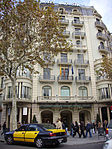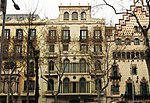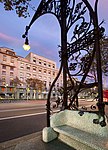Carrer de Pau Claris, Barcelona
EixampleStreets in Barcelona
Carrer de Pau Claris is a street in Eixample, Barcelona. It crosses the district grid perpendicularly to the seafront, between Passeig de Gràcia and Carrer de Roger de Llúria. It starts in Avinguda Diagonal and ends in Plaça Urquinaona, where it becomes Via Laietana. It's the second busiest one-way street in the Eixample district. It's named after the Catalan political leader Pau Claris i Casademunt, who proclaimed the Catalan Republic in 1641.
Excerpt from the Wikipedia article Carrer de Pau Claris, Barcelona (License: CC BY-SA 3.0, Authors).Carrer de Pau Claris, Barcelona
Carrer de Pau Claris, Barcelona
Geographical coordinates (GPS) Address Nearby Places Show on map
Geographical coordinates (GPS)
| Latitude | Longitude |
|---|---|
| N 41.3935 ° | E 2.166 ° |
Address
Carrer de Pau Claris 133-135
08009 Barcelona
Catalonia, Spain
Open on Google Maps










